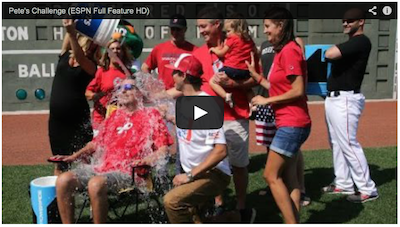It’s a pop culture mash-up between a “double-dog dare” and a selfie with a cause.
Throughout the US, healthcare marketing professionals (and their supervisors) are marveling at this summer’s continuing success of the ALS Association’s Ice Bucket Challenge (IBC). Hospital foundations, medical research associations and the like are amazed and envious of the social media phenomenon and viral marketing success.
It’s a pop culture mash-up between a “double-dog dare” and a selfie with a cause.
Throughout the US, healthcare marketing professionals (and their supervisors) are marveling at this summer’s continuing success of the ALS Association’s Ice Bucket Challenge (IBC). Hospital foundations, medical research associations and the like are amazed and envious of the social media phenomenon and viral marketing success.
If you missed the IBC social explosion—your summer holiday was on the far side of Jupiter or whatever—this FaithReel.com video is a dip in the IBC viral stream and some of the backstory. Friends, neighbors, celebs, performers, politicians, athletes and a few hundred thousand “regular people” have jumped on social media platforms including YouTube, Facebook, Vine, Twitter and others to answer and spread the challenge.
“What luck!” the supervisor is thinking, “We’d like the same good fortune that flows to when something ‘goes viral.’” Well…good fortune, yes. So far, the runaway viral traction of the IBC has indeed educated the public, raised brand awareness, and has (so far) raised tens of millions in donations to the ALS Association (amyotrophic lateral sclerosis) from existing donors and over 630,000 new donors. The Ice Bucket thing is simple, easy to participate, fun, visual, social, and significantly, it has a built-in element for sharing and challenging others to do likewise.
On the other hand, luck is only part of the viral success formula. A healthy dose of good fortune is both a welcome and necessary ingredient. But beyond providence, here are more tips, techniques and marketing lessons if you want your content “going viral” via the Internet and social media.
- There’s no guarantee. Gently remind the boss that “going viral” is never a sure thing, but when it works, you can capture attention and inspire engagement without a big budget.
- It’s not really instant success. The IBC thing had a slow start. It began a couple months before it took off, and at the outset, was it was not connected to a specific charity or cause. A month or two of ramp-up is a long time in the digital world.
- A broad and inclusive audience. By definition, “viral” is able to be spread far and wide. Consider how your content will appeal to and include the largest possible audience. The IBC, as an example, has few rules and virtually no barriers to playing along with the theme or for challenging others to participate.
- Emotional fuel. The main ingredient for “sharing” is “caring.” A strong emotional connection—happy, sad, fear, anger—is what inspires people to spread those feelings among others. Without eliciting feelings, there is little or no attention, caring or sharing.
- Use Humor (maybe). While there’s nothing funny about the debilitating disease, the ice-bucket-dump video clips are good natured and amusing. Among the emotional options (see item above) people like to share a laugh with others. Even in good taste, humor is not always appropriate.
- Social Proof is like a popular bandwagon. In part, people judge value or attach importance to something by what they believe others think or they see others doing. The social proof of popular participation is an implied endorsement that influences others to climb aboard the bandwagon. Participation allows people to be timely and trendy and to feel good and do good.
- The celebrity factor. Greater or lesser celebs attract attention and often influence others, and it’s usually a plus. The Ice Bucket Challenge concept evidently had a head start. According to an item in the Chicago Tribune, the idea “came from a dare that was circulating among a group of pro athletes. Those who declined the ice bath were compelled to give $100 to a charity of the challenger’s choice.” Broad public awareness was propelled by mass media exposure via challengers Jimmy Fallon, Oprah Winfrey and many others.
These and perhaps a dozen other considerations are the ingredients of successful—and highly share-able—social media efforts in healthcare marketing. Watch for an upcoming article about why people share authoritative content online to attract and retain patients.
The ALS Ice Bucket Challenge is, at least for this summertime moment, a pop culture and social media phenomenon that benefited a worthy cause. (More noteworthy than the legacy of last year’s Gangham Style craze.)
The thing about “going viral” is that you know it when you see it, but it’s nearly impossible to predict in advance. You can, however, include these and other ingredients that will gain traction in social media for exposure, awareness and most importantly, sharing.
